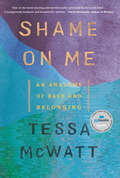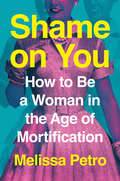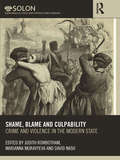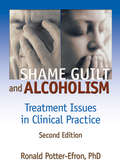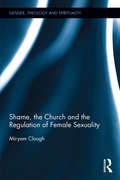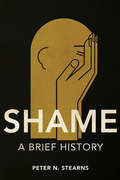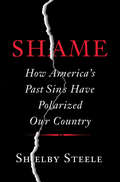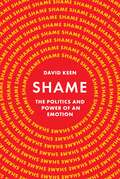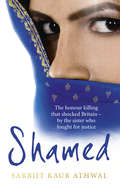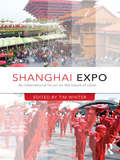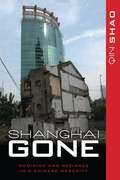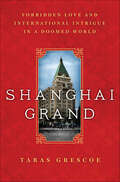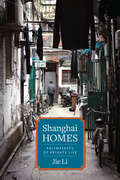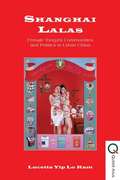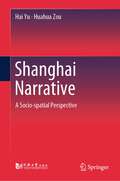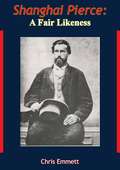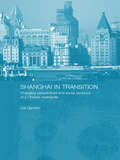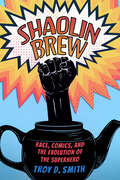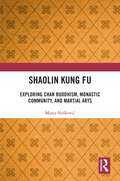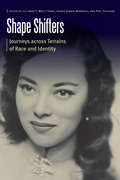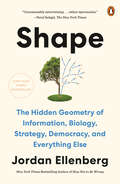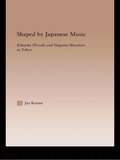- Table View
- List View
Shame on Me: An Anatomy of Race and Belonging
by Tessa McWattInterrogating our ideas of race through the lens of her own multi-racial identity, critically acclaimed novelist Tessa McWatt turns her eye on herself, her body and this world in a powerful new work of non-fiction.Tessa McWatt has been called Susie Wong, Pocahontas and "black bitch," and has been judged not black enough by people who assume she straightens her hair. Now, through a close examination of her own body--nose, lips, hair, skin, eyes, ass, bones and blood--which holds up a mirror to the way culture reads all bodies, she asks why we persist in thinking in terms of race today when racism is killing us. Her grandmother's family fled southern China for British Guiana after her great uncle was shot in his own dentist's chair during the First Sino-Japanese War. McWatt is made of this woman and more: those who arrived in British Guiana from India as indentured labour and those who were brought from Africa as cargo to work on the sugar plantations; colonists and those whom colonialism displaced. How do you tick a box on a census form or job application when your ancestry is Scottish, English, French, Portuguese, Indian, Amerindian, African and Chinese? How do you finally answer a question first posed to you in grade school: "What are you?" And where do you find a sense of belonging in a supposedly "post-racial" world where shadism, fear of blackness, identity politics and call-out culture vie with each other noisily, relentlessly and still lethally? Shame on Me is a personal and powerful exploration of history and identity, colour and desire from a writer who, having been plagued with confusion about her race all her life, has at last found kinship and solidarity in story.
Shame on You: How to Be a Woman in the Age of Mortification
by Melissa PetroIn the spirit of Rebecca Traister's Good and Mad and Roxane Gay's Bad Feminist comes a courageous, in-depth investigation into the modern epidemic of shame in our society—what it is, why women are uniquely susceptible, and how we can shift the shame off our plates and live our best lives in an over-exposed, image-obsessed world.For millions of women, shame is a vicious predator. It tells us we are less than, that we are unworthy. We try everything to escape shame—ignoring it, intellectualizing it, and even, ironically, shaming ourselves for feeling it. The reality is that women experience shame more frequently and more intensely than men—a direct result, as acclaimed journalist Melissa Petro explains, of a patriarchal culture that &“urges women to feel bad about themselves, and then punishes them when they do.&” Why can&’t we figure out how to break the shame cycle once and for all?In Shame on You, Petro takes on the issue of women&’s shame directly with an unflinching look at the social systems that encourage women to believe we are deeply inadequate. From shame&’s beginnings ( Maybe she&’s born with it? Nope, it&’s misogyny.) to its effect on our lives as adults (How the humiliation of &“bad women&” affects us all.), shame poisons our friendships, romantic relationships, and work lives. But it doesn&’t have to be that way. Blending investigative reporting, science, literature, and hundreds of women&’s personal stories—including her own shameful account of winding up as an unwitting New York Post cover girl—Petro offers us a new way forward. No matter what you do, she explains, there is no escaping being judged. And yet, the women we can become—sometimes as a consequence of shame, rather than in spite of it—are powerful indeed. And maybe that&’s what others are afraid of.
Shame, Blame, and Culpability: Crime and violence in the modern state (Routledge SOLON Explorations in Crime and Criminal Justice Histories)
by David Nash Judith Rowbotham Marianna MuravyevaThis ground-breaking collection of research-based chapters addresses the themes of shame, blame and culpability in their historical perspective in the broad area of crime, violence and the modern state, drawing on less familiar territories such as Russia and Greece, not just on material from familiar locations in western Europe. Ranging from the early modern to the late twentieth century, the collection has implications for how we understand punishments imposed by states or the community today. Shame, blame and culpability is divided into three sections, with a crucial case study part complementing two theoretical parts on shame, and on blame and culpability; exploring the continuance of shaming strategies and examining their interaction with and challenge to 'modern' state-sponsored blaming mechanisms, including allocations of culpability. The collection includes chapters on the deviant body, capital punishment and, of particular interest, Russian case studies, which demonstrate the extent to which the Russian, like the Greek, experience need to be seen as part of a wider European whole when examining ideas and themes. The volume challenges ideas that shame strategies were largely eradicated in post-Enlightenment western states and societies; showing their survival into the twentieth century as a challenge to state dominance over identification of what constituted 'crime' and also over punishment practices. Shame, blame and culpability will be a key text for students and academics in the fields of criminology and crime, gender or European history.
Shame, Guilt, and Alcoholism: Treatment Issues in Clinical Practice, Second Edition (Addiction Treatment Ser. #Vol. 2)
by Ron Potter-Efron Bruce CarruthExplore the causes and effects of the shame/guilt/addiction cycle!Since the original edition in 1989, great strides have been made in understanding the overlapping functions of shame and guilt and the ways these painful emotions are linked with addictions. Shame, Guilt, and Alcoholism: Treatment Issues in Clinical Practice, Second Edition, integrates up-to-date psychological research with penetrating insight into the emotional realities of substance abuse. It provides a clear and practical model for understanding the shame/guilt/addiction cycle.Shame, Guilt, and Alcoholism provides constructive suggestions to therapists for treating substance-abusing clients and their affected family members. By treating destructive, inappropriate, or excessive shame and guilt, therapists can help their clients free themselves from the downward spiral of addiction and begin to build on their genuine strengths. It explores the positive functions of shame and guilt, describes the conscious and subconscious defense mechanisms against them, and highlights the crucial family behaviors that initiate and encourage shame and guilt. Shame, Guilt, and Alcoholism thoroughly explains the significant differences between shame and guilt, including: clients’experiences of failure primary responses and feelings precipitating events and involvement of self origins and central fearsShame, Guilt, and Alcoholism adds immeasurably to our understanding of the total recovery process. It is an essential resource for therapists, social workers, psychologists, substance-abuse counselors, and educators in the field.
Shame, the Church and the Regulation of Female Sexuality (Gender, Theology and Spirituality)
by Miryam CloughShame strikes at the heart of human individuals rupturing relationships, extinguishing joy and, at times, provoking conflict and violence. This book explores the idea that shame has historically been, and continues to be, used by an oftentimes patriarchal Christian Church as a mechanism to control and regulate female sexuality and to displace men’s ambivalence about sex. Using a study of Ireland’s Magdalen laundries as a historical example, contemporary feminist theological and theoretical scholarship are utilised to examine why the Church as an institution has routinely colluded with the shaming of individuals, and moreover why women are consistently and overtly shamed on account of, and indeed take the blame for, sex. In addition, the text asks whether the avoidance of shame is in fact functional in men’s efforts to adhere to patriarchal gender norms and religious ideals, and whether women end up paying the price for the maintenance of this system. This book is a fresh take on the issue of shame and gender in the context of religious belief and practice. As such it will be of significant interest to academics in the fields of Religious Studies, but also History, Psychology and Gender Studies.
Shame: A Brief History
by Peter N. StearnsShame varies as an individual experience and its manifestations across time and cultures. Groups establish identity and enforce social behaviors through shame and shaming, while attempts at shaming often provoke a social or political backlash. Yet historians often neglect shame 's power to complicate individual, international, cultural, and political relationships. Peter N. Stearns draws on his long career as a historian of emotions to provide the foundational text on shame 's history and how this history contributes to contemporary issues around the emotion. Summarizing current research, Stearns unpacks the major debates that surround this complex emotion. He also surveys the changing role of shame in the United States from the nineteenth century to today, including shame 's revival as a force in the 1960s and its place in today 's social media. Looking ahead, Stearns maps the abundant opportunities for future historical research and historically informed interdisciplinary scholarship. Written for interested readers and scholars alike, Shame combines significant new research with a wider synthesis.
Shame: How America's Past Sins Have Polarized Our Country
by Shelby SteeleThe greatest barrier to racial equality today is not overt racism, Shelby Steele argues in [Title TK], but white liberals. Under the guise of benevolence, liberals today maintain their position of power over blacks by continuing to cast them as victims in need of saving. This ideology underlies liberal social policies from affirmative action to welfare, which actually exacerbate racial inequality rather than mitigating it. Drawing on empirical data as well as his own personal experience, Steele demonstrates that these policies have not only failed, but have made it impossible to address the problems that plague the modern black community, and have ensured that black Americans will never be truly equal to their white countrymen, in their own minds or in practice. Forthright and persuasive, [Title TK] offers an unflinching look at the failures of liberalism and a compelling case that a return to conservative principles is the only way forward for African Americans--and for the nation.
Shame: The Politics and Power of an Emotion
by David KeenThe uses of shame (and shamelessness) in spheres that range from social media and consumerism to polarized politics and mass violenceToday, we are caught in a shame spiral—a vortex of mutual shaming that pervades everything from politics to social media. We are shamed for our looks, our culture, our ethnicity, our sexuality, our poverty, our wrongdoings, our politics. But what is the point of all this shaming and countershaming? Does it work? And if so, for whom?In Shame, David Keen explores the function of modern shaming, paying particular attention to how shame is instrumentalized and weaponized. Keen points out that there is usually someone who offers an escape from shame—and that many of those who make this offer have been piling on shame in the first place. Self-interested manipulations of shame, Keen argues, are central to understanding phenomena as wide-ranging as consumerism, violent crime, populist politics, and even war and genocide. Shame is political as well as personal. To break out of our current cycle of shame and shaming, and to understand the harm that shame can do, we must recognize the ways that shame is being made to serve political and economic purposes.Keen also traces the rise of leaders on both sides of the Atlantic who possess a dangerous shamelessness, and he asks how shame and shamelessness can both be damaging. Answering this question means understanding the different types of shame. And it means understanding how shame and shamelessness interact—not least when shame is instrumentalized by those who are selling shamelessness. Keen points to a perverse and inequitable distribution of shame, with the victims of poverty and violence frequently being shamed, while those who benefit tend to exhibit shamelessness and even pride.
Shamed: The Honour Killing That Shocked Britain – by the Sister Who Fought for Justice
by Sarbjit Kaur AthwalIn 1998, Sarbjit Athwal was called by her husband to attend a family meeting. It looked like just another family gathering. An attractive house in west London, a large dining room, two brothers, their mother, one wife. But the subject they were discussing was anything but ordinary. At the head of the group sat the elderly mother. She stared proudly around, smiling at her children, then raised her hand for silence. ‘It’s decided then,’ the old lady announced. ‘We have to get rid of her.’‘Her’ was Surjit Athwal, Sarbjit’s sister-in-law. Within three weeks of that meeting, Surjit was dead: lured from London to India, drugged, strangled, and her body dumped in the Ravi River, never to be seen again.After the killing, risking her own life, Sarbjit fought secretly for justice for nine long, scared years. Eventually, with immense bravery, she became the first person within a murderer’s family ever to go into open court in an honour killing trial as the Prosecution’s key witness, and the first to waive her anonymity in such a trial. As a result of her testimony, the trial led to the first successful prosecution of an honour killing without the body ever being found.But her story doesn’t end there. Since the trial, her life has been threatened; her own husband arrested after an allegation of intimidation. Shamed is a story of fear and of horror – but also of immense courage, and a woman who risked everything to see that justice was done.
Shamrocks, Harps, and Shillelaghs: The Story of the St. Patrick's Day Symbols
by Edna BarthSt. Patrick's Day is one of exuberant, merry, traditions. Barth explains the religious, social and political beliefs being commemorated on St. Patrick's Day by explaining the source of the symbols incorporated in the celebrations from dawn till dark. She points out how the holiday observance varies in Ireland from The United States where the population with Irish ancestry is larger than the population of Ireland itself. Concisely she traces the origins and importance of shamrocks harps, and Shillelaghs and goes on to summarize St. Patrick's life and the 30 to 40 years he spent first as a slave and eventually as a Bishop in Ireland. She traces the emergence and meaning of the orange, white and green Irish flag, summarizing Ireland's opposition to English occupation, the deprivations suffered by the Irish and their struggle to preserve their language and heritage. She describes parades, holiday foods, Leprechauns, Fairies, dance and the high value placed on song, poetry and storytelling both in pubs and in world renowned literature. Includes lists of Stories for St. Patrick's day, resources and an index.
Shanghai Expo: An International Forum on the Future of Cities (CRESC)
by Tim WinterIn 2010 Shanghai hosted the largest, most spectacular and most expensive expo ever. Attracting a staggering 73 million visitors, and costing around US$45 billion dollars, Shanghai Expo broke the records in the history of world's fairs and universal expositions. With more than half of the world’s population now living in cities, many of which face uncertain futures, this mega event confronted some of the key challenges facing humanity in the 21st Century, with its theme Better City, Better Life. Just two years after the Beijing Olympics, Shanghai Expo encapsulated a moment in history defined by China’s rise as a global superpower, and by the multiple challenges associated with developing more sustainable cities. The thirteen essays here, written by a team of interdisciplinary researchers, offer a uniquely detailed analysis of this globally significant event. Chapters examine displays of futurity and utopia, the limitations of inter-cultural dialogue, and the ways in which this mega-event reflected its geo-political and cultural moment. Shanghai Expo also concentrates on the interplay between declarations towards urban sustainability, and the recent economic, demographic and socio-political trajectories of Shanghai and China more broadly. It will appeal to students and scholars of sociology, history, politics, international relations, economics, Asian studies, China studies, sustainability, and urban studies.
Shanghai Gone: Domicide and Defiance in a Chinese Megacity (State & Society in East Asia)
by Qin Shao&“One of the best accounts of the reality of gentrification and urban development in China . . . grounded with solid historical, ethnographic and legal evidence&” (Urban Studies). In recent decades, the centuries-old city of Shanghai has been demolished and rebuilt into a gleaming megacity. With its world famous skyscrapers, it now ranks with New York and London as a hub of global finance. But that transformation has come at a grave human cost. In Shanghai Gone, Qin Shao applies the concept of domicide—the eradication of a home against the will of its dwellers—to the sweeping destruction of neighborhoods, families, and life patterns that made way for the new Shanghai. Shao gives voice to the holdouts and protesters who resisted domicide and demanded justice. She follows, among others, a reticent kindergarten teacher turned diehard petitioner; a descendant of gangsters and squatters who has become an amateur lawyer for evictees; and a Chinese Muslim who has struggled to recover his ancestral home in Xintiandi, an infamous site of gentrification dominated by a well-connected Hong Kong real estate tycoon. Highlighting the wrenching changes spawned by China&’s reform era, Shao vividly portrays the corrupt and rapacious pursuit of growth and profit, the personal wreckage it has left behind, and the enduring human spirit it has unleashed.
Shanghai Grand: Forbidden Love and International Intrigue in a Doomed World
by Taras GrescoeThe true story of a British aristocrat, an American flapper, and a Chinese poet trapped in an unlikely love triangle amid the decadence of Jazz Age Shanghai.On the eve of World War II, the foreign-controlled port of Shanghai was the rendezvous for the twentieth century’s most outlandish adventurers, all under the watchful eye of the fabulously wealthy Sir Victor Sassoon.Emily “Mickey” Hahn was a legendary New Yorker journalist whose vivid writing played a crucial role in opening Western eyes to the realities of life in China.At the height of the Depression, Hahn arrives in Shanghai after a disappointing affair with an alcoholic Hollywood screenwriter, convinced she would never love again. After checking in to Sassoon’s glamorous Cathay Hotel, Hahn is absorbed into the social swirl of the expats drawn to pre-war China, among them Ernest Hemingway, Martha Gellhorn, Harold Acton, and a colorful gangster named Morris “Two-Gun” Cohen. But when she meets Zau Sinmay, a Chinese poet from an illustrious family, she discovers the real Shanghai through his eyes: the city of rich colonials, triple agents, opium smokers, displaced Chinese peasants, and increasingly desperate White Russian and Jewish refugees—a place her innate curiosity will lead her to explore firsthand. Danger lurks on the horizon, though, as the brutal Japanese occupation destroys the seductive world of pre-war Shanghai, paving the way for Mao Tse-tung’s Communists’ rise to power.Praise for Shanghai Grand“A headlong swoon for old Shanghai. The feeling is easy to catch.” —The New York Times Book Review“Filled with excellent short character sketches and keeps the reader turning the pages to find out what happens next . . . Brings to life a special time and a special place.” —The Wall Street Journal“Grescoe exuberantly captures the glamour and intrigue of a lost world.” —Kirkus Reviews
Shanghai Homes: Palimpsests of Private Life
by Jie LiExploring three dimensions of private life territories, artifacts, and gossip Li re-creates the sounds, smells, look, and feel of home over a tumultuous century
Shanghai Homes: Palimpsests of Private Life (Global Chinese Culture)
by Jie LiIn the dazzling global metropolis of Shanghai, what has it meant to call this city home? In this account—part microhistory, part memoir—Jie Li salvages intimate recollections by successive generations of inhabitants of two vibrant, culturally mixed Shanghai alleyways from the Republican, Maoist, and post-Mao eras. Exploring three dimensions of private life—territories, artifacts, and gossip—Li re-creates the sounds, smells, look, and feel of home over a tumultuous century. First built by British and Japanese companies in 1915 and 1927, the two homes at the center of this narrative were located in an industrial part of the former "International Settlement." Before their recent demolition, they were nestled in Shanghai's labyrinthine alleyways, which housed more than half of the city's population from the Sino-Japanese War to the Cultural Revolution. Through interviews with her own family members as well as their neighbors, classmates, and co-workers, Li weaves a complex social tapestry reflecting the lived experiences of ordinary people struggling to absorb and adapt to major historical change. These voices include workers, intellectuals, Communists, Nationalists, foreigners, compradors, wives, concubines, and children who all fought for a foothold and haven in this city, witnessing spectacles so full of farce and pathos they could only be whispered as secret histories.
Shanghai Lalas: Female Tongzhi Communities and Politics in Urban China
by Lucetta Yip Lo KamThis is the first ethnographic study of 'lala' (lesbian, bisexual, and transgender) communities and politics in China, focusing on the city of Shanghai. Based on several years of in-depth interviews, the volume concentrates on 'lala's' everyday struggle to reconcile same-sex desire with a dominant rhetoric of family harmony and compulsory marriage, all within a culture denying women's active and legitimate sexual agency. Lucetta Yip Lo Kam reads discourses on homophobia in China, including the rhetoric of 'Chinese tolerance' and considers the heteronormative demands imposed on 'tongzhi' subjects. She treats 'the politics of public correctness' as a newly emerging 'tongzhi' practice developed from the culturally specific, Chinese forms of regulation that inform 'tongzhi' survival strategies and self-identification.
Shanghai Narrative: A Socio-spatial Perspective
by Hai Yu Huahua ZouThis book focuses on urban development in Shanghai over the past four decades, which is composed of two major development processes—the development of new spaces and the renewal of old ones. Seeking to bring the concept of space back into social analysis, the book explores changes affecting communities, interpersonal interactions, lifestyles and social mindsets in Shanghai from a spatial perspective. What’s more, all these social themes are presented using a narrative of spatial representation and spatialization. The book combines both academic and documentary-style contributions. It also provides cutting-edge research on the most representative case in Shanghai. As the book demonstrates, the story of social spaces in Shanghai is more than a combination of social analysis and spatial analysis but also involves historical analysis and contemporary narrative.
Shanghai Pierce: A Fair Likeness
by Chris Emmett“I am Shanghai Pierce, Webster in Cattle, by God, Sir.” And, in truth, he was. Part rascal, part gentleman, part poseur, part just himself—of all the colorful Texas figures following the Civil War none was as loud, garish, and funny as Shanghai Pierce, who left Rhode Island penniless and became one of the Big Pasture Men of southern Texas.At six foot, four, Shanghai Pierce was big, rich, and selfish, but he could also be kind. His cunning was seldom matched, and business, whether it involved a quarter-million-dollar loan or a twenty-five cent pair of socks, was his lifeblood.In recreating the life of Abel Head (“Shanghai”) Pierce, Chris Emmett unfolds the entire dramatic spectacle of the time and place in which Pierce lived. An arresting figure, Pierce was a symbol of his era. His statue, which he himself erected in Hawley, Texas, is still a perfect memorial to, and a reminder of, westward-moving America. Shanghai Pierce was a man who pulled up his roots and fled to the West, where he found there was ample room and opportunity.First published in 1953, Shanghai Pierce: A Fair Likeness won the 1953 Summerfield G. Roberts award of the Texas Institute of Letters for the best book on the Republic of Texas.
Shanghai in Transition: Changing Perspectives and Social Contours of a Chinese Metropolis
by Jos GambleIn the decades following the introduction of Communist Party rule in Shanghai in 1949, the city's economy, infrastructure and links with the world all atrophied. However, the past decade has seen far-reaching economic reforms implemented to recreate Shanghai as a cosmopolitan, world financial and trade centre. This book focuses on the lives of local residents and their perceptions of their changing city, and presents an evocative series of ethnographic perspectives of the city's shifting sociological landscape in this period of transition.
Shantytown, USA: Forgotten Landscapes of the Working Poor
by Lisa GoffShantytowns once occupied a central place in America's urban landscape. Lisa Goff shows how these resourceful dwellings were not merely the byproducts of hardship but potent assertions of self-reliance. Their legacy is felt in sites of political activism, from campus shanties protesting apartheid to the tent cities of Occupy Wall Street.
Shaolin Brew: Race, Comics, and the Evolution of the Superhero
by Troy D. SmithShaolin Brew: Race, Comics, and the Evolution of the Superhero looks at how the comic book industry developed from a white perspective and how minority characters were and are viewed through a stereotypical white gaze. Further, the book explores how voices of color have launched a shift in the industry, taking nonwhite characters who were originally viewed through a white lens and situating them outside the framework of whiteness. The financial success of Blaxploitation and Kung Fu films in the early 1970s led to major comics publishers creating, for the first time, Black and Asian superhero characters who headlined their own comics. The introduction of Black and Asian main characters, who previously only served as guest stars or sidekicks, launched a new kind of engagement between comics companies and minority characters and readers. However, scripted as they were by white writers, these characters were mired in stereotypes. Author Troy D. Smith focuses on Asian, Black, and Latinx representation in the comic industry and how it has evolved over the years. Smith explores topics that include Orientalism, whitewashing, Black respectability politics, the model minority myth, and political controversies facing fandoms. In particular, Smith examines how fans take the superheroes they grew up with—such as Luke Cage, Black Lightning, and Shang Chi—and turn them into the characters they wished they had as children. Shaolin Brew delves into the efforts of fans of color who urged creators to make these characters more realistic. This refining process increased as more writers and artists of color broke into the industry, bringing their own perspectives to the characters. As many of these characters transitioned from page to screen, a new generation of writers, artists, and readers have cooperated to evolve one-dimensional stereotypes into multifaceted, dynamic heroes.
Shaolin Kung Fu: Exploring Chan Buddhism, Monastic Community, and Martial Arts
by Marta NeškovićThis book investigates contemporary Shaolin Kung Fu, situated between tradition and modernity. Deeply rooted in the philosophical and religious traditions of Chan Buddhism and concurrently evolving under the influence of globalization, this martial art serves as a Chan Buddhist practice within the Shaolin monastic community. Illuminating the rich cultural heritage of Shaolin Kung Fu and its ongoing relevance in the contemporary world, the analysis is grounded in long-term ethnographic fieldwork conducted at the Shaolin Monastery in Henan Province, China. The author argues that the spiritual essence of Shaolin Kung Fu is derived not from its constituent elements, such as body movements and techniques, but rather from the Chan Buddhist structures of meaning the practitioners embody. By highlighting the relationship between habitus, lived body, and dynamic embodiment, the book offers a novel perspective on the intersection of spirituality and martial arts. Providing a deeper understanding of the cultural, religious, and philosophical foundations that underpin Shaolin Kung Fu, this is a valuable reading for scholars of anthropology, sociology, religious studies, cultural heritage, and China studies, as well as for academics and practitioners with an interest in martial arts.
Shape Shifters: Journeys across Terrains of Race and Identity (Borderlands and Transcultural Studies)
by Paul Spickard Ingrid Dineen-Wimberly Lily Anne Y. Welty TamaiShape Shifters presents a wide-ranging array of essays that examine peoples of mixed racial identity. Moving beyond the static &“either/or&” categories of racial identification found within typical insular conversations about mixed-race peoples, Shape Shifters explores these mixed-race identities as fluid, ambiguous, contingent, multiple, and malleable. This volume expands our understandings of how individuals and ethnic groups identify themselves within their own sociohistorical contexts. The essays in Shape Shifters explore different historical eras and reach across the globe, from the Roman and Chinese borderlands of classical antiquity to medieval Eurasian shape shifters, the Native peoples of the missions of Spanish California, and racial shape shifting among African Americans in the post–civil rights era. At different times in their lives or over generations in their families, racial shape shifters have moved from one social context to another. And as new social contexts were imposed on them, identities have even changed from one group to another. This is not racial, ethnic, or religious imposture. It is simply the way that people&’s lives unfold in fluid sociohistorical circumstances. With contributions by Ryan Abrecht, George J. Sánchez, Laura Moore, and Margaret Hunter, among others, Shape Shifters explores the forces of migration, borderlands, trade, warfare, occupation, colonial imposition, and the creation and dissolution of states and empires to highlight the historically contingent basis of identification among mixed-race peoples across time and space.
Shape: The Hidden Geometry of Information, Biology, Strategy, Democracy, and Everything Else
by Jordan EllenbergFrom the New York Times-bestselling author of How Not to Be Wrong—himself a world-class geometer—a far-ranging exploration of the power of geometry, which turns out to help us think better about practically everything. <P><P>How should a democracy choose its representatives? How can you stop a pandemic from sweeping the world? How do computers learn to play Go, and why is learning Go so much easier for them than learning to read a sentence? Can ancient Greek proportions predict the stock market? (Sorry, no.) What should your kids learn in school if they really want to learn to think? All these are questions about geometry. For real. <P><P>If you're like most people, geometry is a sterile and dimly remembered exercise you gladly left behind in the dust of ninth grade, along with your braces and active romantic interest in pop singers. If you recall any of it, it's plodding through a series of miniscule steps only to prove some fact about triangles that was obvious to you in the first place. That's not geometry. Okay, it is geometry, but only a tiny part, which has as much to do with geometry in all its flush modern richness as conjugating a verb has to do with a great novel. <P><P>Shape reveals the geometry underneath some of the most important scientific, political, and philosophical problems we face. Geometry asks: Where are things? Which things are near each other? How can you get from one thing to another thing? Those are important questions. The word "geometry," from the Greek for "measuring the world." If anything, that's an undersell. Geometry doesn't just measure the world—it explains it. Shape shows us how. <P><P><b>A New York Times Bestseller</b>
Shaped by Japanese Music: Kikuoka Hiroaki and Nagauta Shamisen in Tokyo (Current Research in Ethnomusicology: Outstanding Dissertations #10)
by Jay Davis KeisterShaped by Japanese Music is an in-depth analysis of the musical world of an individual performer, composer, and teacher. Using an ethnographic approach, this study situates musical analysis in the context of its creation, demonstrating that traditional Japanese music is hardly an archaic song form frozen in the present, but an active sociocultural system that has been reproduced in Japan from the seventeenth century to the present day. The dynamics of this cultural system unfold in the musical experiences of Kikuoka Hiroaki, the leader of a school of nagauta music, who struggled to modernize the art form while trying to maintain the qualities he believed to be fundamental to the tradition. Through the focus on Kikuoka's school, readers will become familiar with conflicts in the recent history of this music, traditional Japanese teaching methods, and the technique of modern composition within a traditional form. Underlying all of these different analyses is the concept of kata (form), a Japanese aesthetic that helps shape musical forms as well as the behaviour of musicians.
